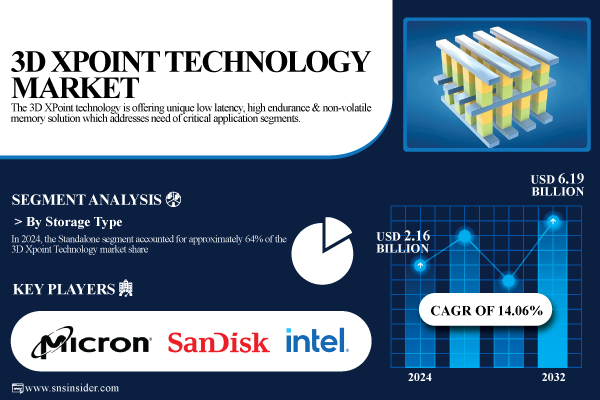3D XPoint Technology Market Set to Reach USD 6.19 Billion by 2032

The global market for 3D XPoint Technology is projected to grow significantly, with estimates indicating an increase from USD 2.16 billion in 2024 to USD 6.19 billion by 2032. This growth represents a compound annual growth rate (CAGR) of 14.06% from 2025 to 2032, according to a report by SNS Insider released on August 28, 2025.
Key Drivers of Market Growth
3D XPoint technology stands out due to its low latency and high endurance, offering a non-volatile memory solution that effectively bridges the gap between DRAM and NAND flash technologies. This capability enables faster boot times, real-time analytics, and improved server efficiency. The technology has found widespread application in sectors such as enterprise storage, artificial intelligence (AI), in-memory computing, and database management. It supports persistent memory architectures that are critical for data-heavy workloads in industries like finance, healthcare, cloud computing, and scientific research.
Despite Intel’s decision to phase out its Optane DIMMs by 2025, the demand for high-speed, durable memory continues to rise. This surge is driven by advancements in AI, high-performance computing (HPC), hybrid memory systems, and energy-efficient data centers. New entrants to the market, such as Numemory from China, are enhancing speed and endurance, further promoting the adoption of 3D XPoint technology in next-generation computing infrastructures.
Market Segmentation and Trends
The report details several key segments within the 3D XPoint technology market. In 2024, the standalone segment dominated with approximately 64% of the market share. This segment is favored for its independent operation and high read/write speeds, making it ideal for data centers and applications in AI, machine learning, and big data analytics. The hybrid segment, however, is expected to experience the fastest growth, with a projected CAGR of 17.18% from 2025 to 2032, primarily due to its cost-effective performance and ease of integration into existing systems.
When examining market segments by storage capacity, the 750GB category held around 64% of the market in 2024. It is particularly popular in enterprise and data center applications that demand high-speed, reliable access. In contrast, the 1.5TB segment is anticipated to grow at the fastest rate, with a CAGR of 20.08% during the same period, reflecting a rising need for high-capacity, low-latency memory in HPC and cloud infrastructure.
The enterprise storage segment accounted for approximately 39% of the market in 2024, driven by the technology’s high-speed performance and durability. Looking forward, the automotive segment is expected to grow the fastest, with a CAGR of 20.08%, fueled by the increasing adoption of advanced driver-assistance systems (ADAS) and autonomous driving technologies.
Geographically, North America led the market in 2024, capturing 44% of the revenue share, supported by major technology players and strong demand from data centers and cloud infrastructure. The Asia-Pacific region is projected to see the highest growth rate, with a CAGR of 15.84% from 2025 to 2032, driven by electronics manufacturing and government investments in high-performance memory solutions.
In summary, the future of the 3D XPoint technology market looks promising, with robust growth across multiple segments and applications. As industries increasingly demand faster, more durable, and energy-efficient memory solutions, the technology is poised to play a pivotal role in the evolution of next-generation computing.






